maintenance schedule MAZDA MODEL TRIBUTE 2006 Owners Manual (in English)
[x] Cancel search | Manufacturer: MAZDA, Model Year: 2006, Model line: MODEL TRIBUTE, Model: MAZDA MODEL TRIBUTE 2006Pages: 288, PDF Size: 2.6 MB
Page 133 of 288
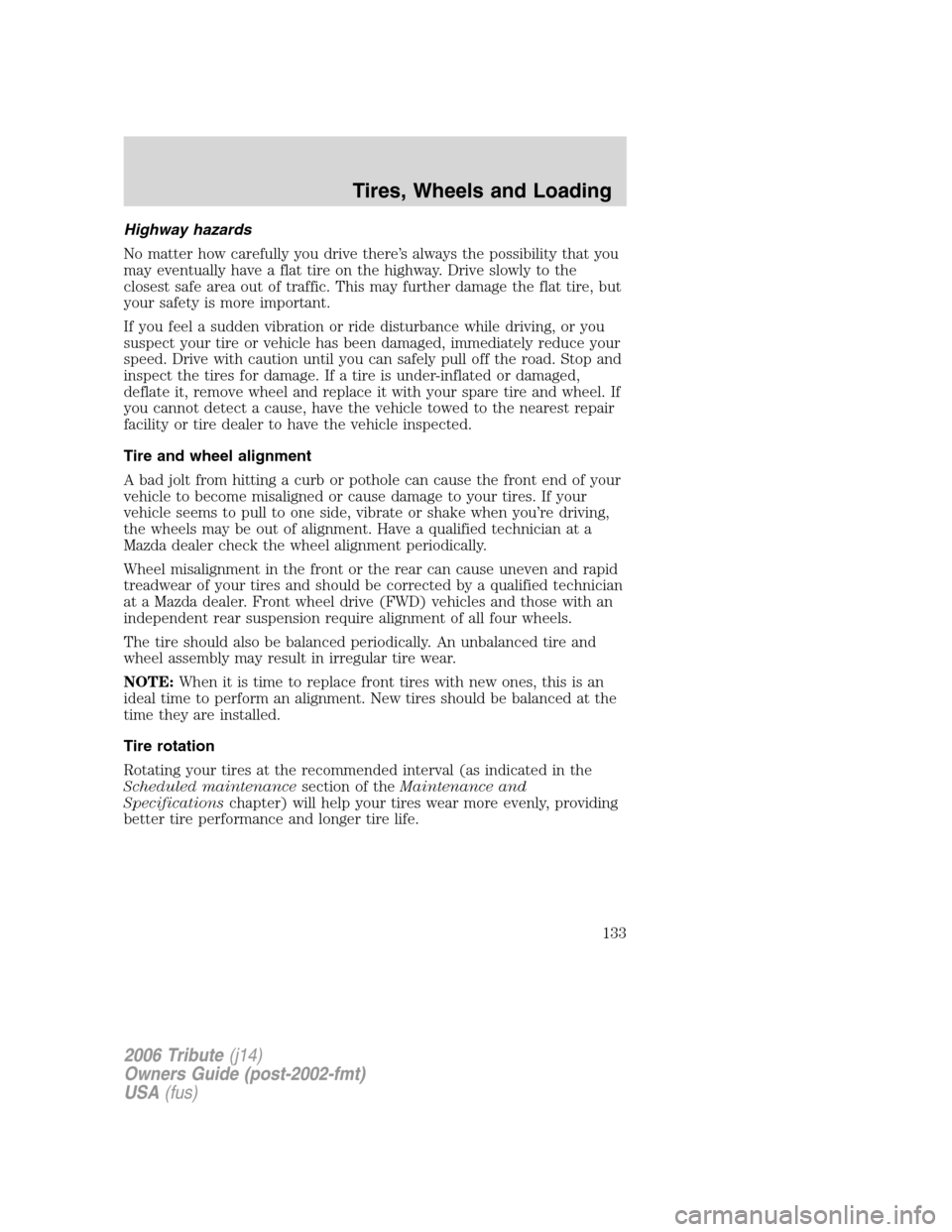
Highway hazards
No matter how carefully you drive there’s always the possibility that you
may eventually have a flat tire on the highway. Drive slowly to the
closest safe area out of traffic. This may further damage the flat tire, but
your safety is more important.
If you feel a sudden vibration or ride disturbance while driving, or you
suspect your tire or vehicle has been damaged, immediately reduce your
speed. Drive with caution until you can safely pull off the road. Stop and
inspect the tires for damage. If a tire is under-inflated or damaged,
deflate it, remove wheel and replace it with your spare tire and wheel. If
you cannot detect a cause, have the vehicle towed to the nearest repair
facility or tire dealer to have the vehicle inspected.
Tire and wheel alignment
A bad jolt from hitting a curb or pothole can cause the front end of your
vehicle to become misaligned or cause damage to your tires. If your
vehicle seems to pull to one side, vibrate or shake when you’re driving,
the wheels may be out of alignment. Have a qualified technician at a
Mazda dealer check the wheel alignment periodically.
Wheel misalignment in the front or the rear can cause uneven and rapid
treadwear of your tires and should be corrected by a qualified technician
at a Mazda dealer. Front wheel drive (FWD) vehicles and those with an
independent rear suspension require alignment of all four wheels.
The tire should also be balanced periodically. An unbalanced tire and
wheel assembly may result in irregular tire wear.
NOTE:When it is time to replace front tires with new ones, this is an
ideal time to perform an alignment. New tires should be balanced at the
time they are installed.
Tire rotation
Rotating your tires at the recommended interval (as indicated in the
Scheduled maintenancesection of theMaintenance and
Specificationschapter) will help your tires wear more evenly, providing
better tire performance and longer tire life.
2006 Tribute(j14)
Owners Guide (post-2002-fmt)
USA(fus)
Tires, Wheels and Loading
133
Page 153 of 288
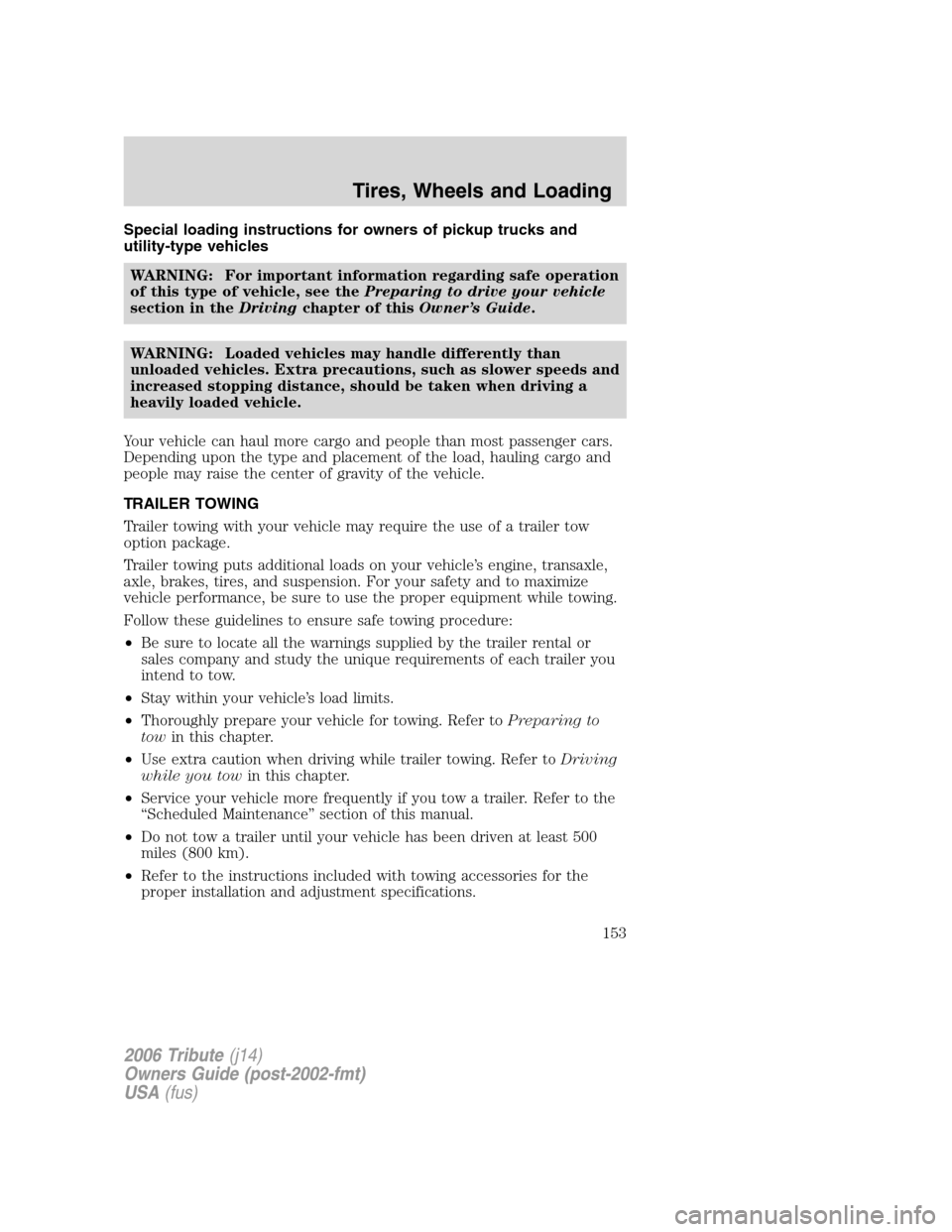
Special loading instructions for owners of pickup trucks and
utility-type vehicles
WARNING: For important information regarding safe operation
of this type of vehicle, see thePreparing to drive your vehicle
section in theDrivingchapter of thisOwner’s Guide.
WARNING: Loaded vehicles may handle differently than
unloaded vehicles. Extra precautions, such as slower speeds and
increased stopping distance, should be taken when driving a
heavily loaded vehicle.
Your vehicle can haul more cargo and people than most passenger cars.
Depending upon the type and placement of the load, hauling cargo and
people may raise the center of gravity of the vehicle.
TRAILER TOWING
Trailer towing with your vehicle may require the use of a trailer tow
option package.
Trailer towing puts additional loads on your vehicle’s engine, transaxle,
axle, brakes, tires, and suspension. For your safety and to maximize
vehicle performance, be sure to use the proper equipment while towing.
Follow these guidelines to ensure safe towing procedure:
•Be sure to locate all the warnings supplied by the trailer rental or
sales company and study the unique requirements of each trailer you
intend to tow.
•Stay within your vehicle’s load limits.
•Thoroughly prepare your vehicle for towing. Refer toPreparing to
towin this chapter.
•Use extra caution when driving while trailer towing. Refer toDriving
while you towin this chapter.
•Service your vehicle more frequently if you tow a trailer. Refer to the
“Scheduled Maintenance” section of this manual.
•Do not tow a trailer until your vehicle has been driven at least 500
miles (800 km).
•Refer to the instructions included with towing accessories for the
proper installation and adjustment specifications.
2006 Tribute(j14)
Owners Guide (post-2002-fmt)
USA(fus)
Tires, Wheels and Loading
153
Page 157 of 288
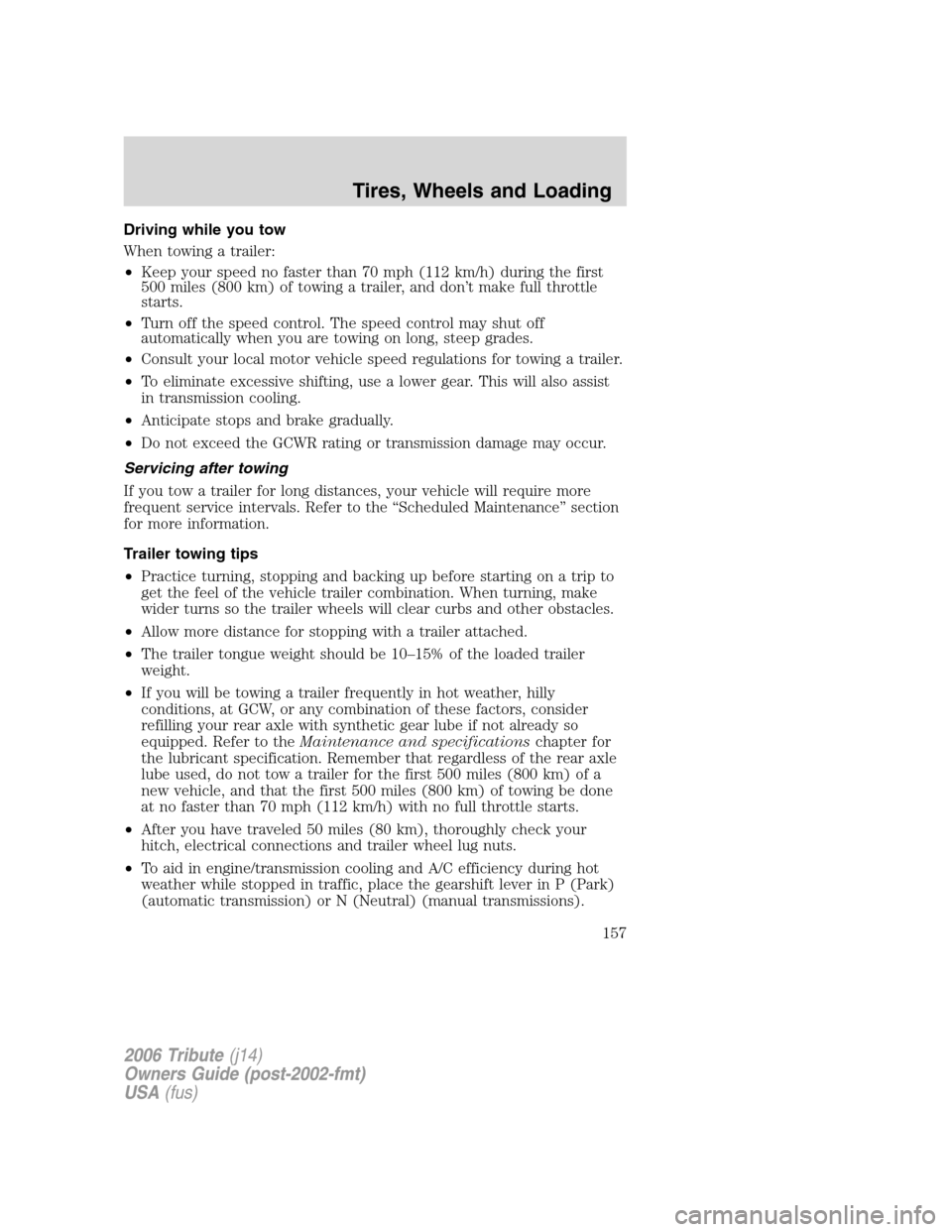
Driving while you tow
When towing a trailer:
•Keep your speed no faster than 70 mph (112 km/h) during the first
500 miles (800 km) of towing a trailer, and don’t make full throttle
starts.
•Turn off the speed control. The speed control may shut off
automatically when you are towing on long, steep grades.
•Consult your local motor vehicle speed regulations for towing a trailer.
•To eliminate excessive shifting, use a lower gear. This will also assist
in transmission cooling.
•Anticipate stops and brake gradually.
•Do not exceed the GCWR rating or transmission damage may occur.
Servicing after towing
If you tow a trailer for long distances, your vehicle will require more
frequent service intervals. Refer to the “Scheduled Maintenance” section
for more information.
Trailer towing tips
•Practice turning, stopping and backing up before starting on a trip to
get the feel of the vehicle trailer combination. When turning, make
wider turns so the trailer wheels will clear curbs and other obstacles.
•Allow more distance for stopping with a trailer attached.
•The trailer tongue weight should be 10–15% of the loaded trailer
weight.
•If you will be towing a trailer frequently in hot weather, hilly
conditions, at GCW, or any combination of these factors, consider
refilling your rear axle with synthetic gear lube if not already so
equipped. Refer to theMaintenance and specificationschapter for
the lubricant specification. Remember that regardless of the rear axle
lube used, do not tow a trailer for the first 500 miles (800 km) of a
new vehicle, and that the first 500 miles (800 km) of towing be done
at no faster than 70 mph (112 km/h) with no full throttle starts.
•After you have traveled 50 miles (80 km), thoroughly check your
hitch, electrical connections and trailer wheel lug nuts.
•To aid in engine/transmission cooling and A/C efficiency during hot
weather while stopped in traffic, place the gearshift lever in P (Park)
(automatic transmission) or N (Neutral) (manual transmissions).
2006 Tribute(j14)
Owners Guide (post-2002-fmt)
USA(fus)
Tires, Wheels and Loading
157
Page 163 of 288

Note:Improve vehicle ventilation by
keeping all air inlet vents clear of
snow, leaves and other debris.
USING THE ENGINE BLOCK HEATER (IF EQUIPPED)
An engine block heater warms the engine coolant, which improves
starting, warms up the engine faster and allows the heater-defroster
system to respond quickly. Use of an engine block heater is strongly
recommended if you live in a region where temperatures reach -10°F
(-23°C) or below.
For best results, plug the heater in at least three hours before starting
the vehicle. Using the heater for longer than three hours will not harm
the engine, so the heater can be plugged in the night before starting the
vehicle.
WARNING: To reduce the risk of electrical shock, do not use
your heater with ungrounded electrical systems or two-pronged
(cheater) adapters.
BRAKES
Your service brakes are self-adjusting. For service maintenance section
about the brakes, refer to theScheduled maintenancesection in the
Maintenance and Specificationchapter.
Occasional brake noise is normal and often does not indicate a
performance concern with the vehicle’s brake system. In normal
operation, automotive brake systems may emit occasional or intermittent
squeal or groan noises when the brakes are applied. Such noises are
usually heard during the first few brake applications in the morning;
however, they may be heard at any time while braking and can be
aggravated by environmental conditions such as cold, heat, moisture,
road dust, salt or mud. If a “metal-to-metal,” “continuous grinding” or
“continuous squeal” sound is present while braking, the brake linings
may be worn-out and should be inspected by an authorized dealer.
2006 Tribute(j14)
Owners Guide (post-2002-fmt)
USA(fus)
Driving
163
Page 229 of 288

INTRODUCTION
Be extremely careful to prevent injury to yourself and others or damage
to your vehicle when using this manual for inspection and maintenance.
If you’re unsure about any procedure it describes, we strongly urge you
to have a reliable and qualified service shop perform the work, preferably
an authorized Mazda Dealer.
Factory-trained Mazda technicians and genuine Mazda parts are best for
your vehicle. Without this expertise and the parts that have been
designed and made especially for your Mazda, inadequate, incomplete,
and insufficient servicing may result in problems. This could lead to
vehicle damage or an accident and injuries.
For expert advice and quality service, consult an authorized Mazda Dealer.
The owner should retain evidence that proper maintenance has been
performed as prescribed.
Claims against the warranty resulting from lack of maintenance, as
opposed to defective materials or authorized Mazda workmanship, will
not be honored.
Any auto repair shop using parts equivalent to your Mazda’s original
equipment may perform maintenance.But we recommend that it
always be done by an authorized Mazda Dealer using genuine
Mazda parts.
SCHEDULED MAINTENANCE
Follow Schedule 1 if the vehicle is operated mainly where none of the
following conditions apply.
If any do apply, follow Schedule 2 (Canada and Puerto Rico residents
follow Schedule 2).
•Repeated short-distance driving
•Driving in dusty conditions
•Driving with an extended use of brakes
•Driving in areas where salt or other corrosive materials are being used
•Driving on rough or muddy roads
•Extended periods of idling or low-speed operation
•Driving for long periods in cold temperatures or extremely humid
climates
•Towing a trailer or using a car-top carrier
NOTE:After the described period, continue to follow the described
maintenance at the recommended intervals.
2006 Tribute(j14)
Owners Guide (post-2002-fmt)
USA(fus)
Maintenance and Specifications
229
Page 230 of 288

SCHEDULE 1
I: Inspect and repair, clean, adjust, or replace if necessary
(Oil-permeated air filter cannot be cleaned using the air-blow method)
R: Replace
L: Lubricate
Maintenance ItemMaintenance Interval (Number of months or km (miles),
whichever comes first)
Months 6 1218243036424854606672
x 1000 Km 12 24 36 48 60 72 84 96 108 120 132 144
(x 1000 Miles) (7.5) (15) (22.5) (30) (37.5) (45) (52.5) (60) (67.5) (75) (82.5) (90)
ENGINE
Engine valve clearance (for 2.3L
engine)Audible inspect every 120,000 km (75,000 miles), if
noisy, adjust
Engine oil R R R R R R R R R R R R
Oil filter R R R R R R R R R R R R
Drive belts (tension) 2.3L engine I I
3.0L engine I I I
PCV valve (for 3.0L
engine)*1 Replace every 160,000 km (100,000 miles)
IGNITION SYSTEM
Spark plugs Replace every 120,000 km (75,000 miles)
FUEL SYSTEM
Air cleaner filter R R
Fuel filter *1 R R R
Fuel lines and hoses *1 I I I
Hoses and tubes for
emission*1 I
COOLING SYSTEM
Cooling system and hoses I I I
Engine coolant (yellow) Replace at first 160,000 km (100,000 miles) or 60
months; after that, every 80,000 km (50,000 miles)
or 36 months
Engine coolant level I I I I I I I I I I I I
2006 Tribute(j14)
Owners Guide (post-2002-fmt)
USA(fus)
Maintenance and Specifications
230
Page 232 of 288

SCHEDULE 2
I: Inspect and repair, clean, adjust, or replace if necessary
(Oil-permeated air filter cannot be cleaned using the air-blow method)
R: Replace
L: Lubricate
Maintenance ItemMaintenance Interval (Number of months or km (miles),
whichever comes first)
Months 4 8 12 16 20 24 28 32 36 40 44 48
x 1000 Km 8 16 24 32 40 48 56 64 72 80 88 96
(x 1000 Miles) (5) (10) (15) (20) (25) (30) (35) (40) (45) (50) (55) (60)
ENGINE
Engine valve clearance (for 2.3L
engine)Audible inspect every 120,000 km (75,000 miles), if
noisy, adjust
Engine oil R R RRRRRRRRRR
Engine oil (for Puerto Rico) Replace every 5,000 km (3,000 miles) (or 3
months)
Oil filter R R RRRRRRRRRR
Drive belts (tension) 2.3L engine I
3.0L engine I I
PCV valve (for 3.0L
engine)*1 Replace every 160,000 km (100,000 miles)
IGNITION SYSTEM
Spark plugs USA Replace every 96,000 km (60,000 miles)
Others *2 Replace every 120,000 km (75,000 miles)
FUEL SYSTEM
Air cleaner filter Puerto Rico R R
Others R
Fuel filter *1 R R
Fuel lines & hoses *1 I I
Hoses and tubes for
emission*1
I
COOLING SYSTEM
Cooling system and hoses I I
2006 Tribute(j14)
Owners Guide (post-2002-fmt)
USA(fus)
Maintenance and Specifications
232
Page 234 of 288
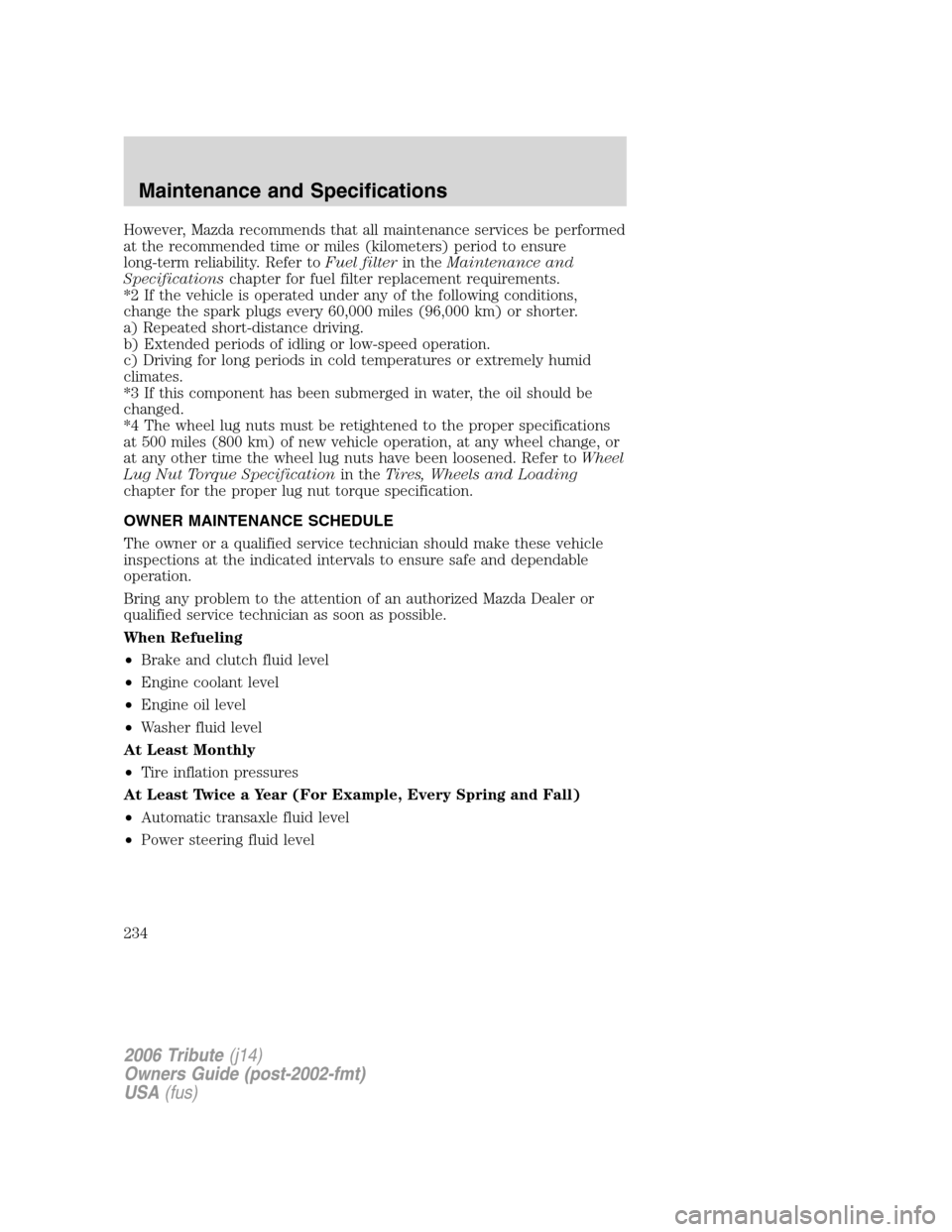
However, Mazda recommends that all maintenance services be performed
at the recommended time or miles (kilometers) period to ensure
long-term reliability. Refer toFuel filterin theMaintenance and
Specificationschapter for fuel filter replacement requirements.
*2 If the vehicle is operated under any of the following conditions,
change the spark plugs every 60,000 miles (96,000 km) or shorter.
a) Repeated short-distance driving.
b) Extended periods of idling or low-speed operation.
c) Driving for long periods in cold temperatures or extremely humid
climates.
*3 If this component has been submerged in water, the oil should be
changed.
*4 The wheel lug nuts must be retightened to the proper specifications
at 500 miles (800 km) of new vehicle operation, at any wheel change, or
at any other time the wheel lug nuts have been loosened. Refer toWheel
Lug Nut Torque Specificationin theTires, Wheels and Loading
chapter for the proper lug nut torque specification.
OWNER MAINTENANCE SCHEDULE
The owner or a qualified service technician should make these vehicle
inspections at the indicated intervals to ensure safe and dependable
operation.
Bring any problem to the attention of an authorized Mazda Dealer or
qualified service technician as soon as possible.
When Refueling
•Brake and clutch fluid level
•Engine coolant level
•Engine oil level
•Washer fluid level
At Least Monthly
•Tire inflation pressures
At Least Twice a Year (For Example, Every Spring and Fall)
•Automatic transaxle fluid level
•Power steering fluid level
2006 Tribute(j14)
Owners Guide (post-2002-fmt)
USA(fus)
Maintenance and Specifications
234
Page 244 of 288
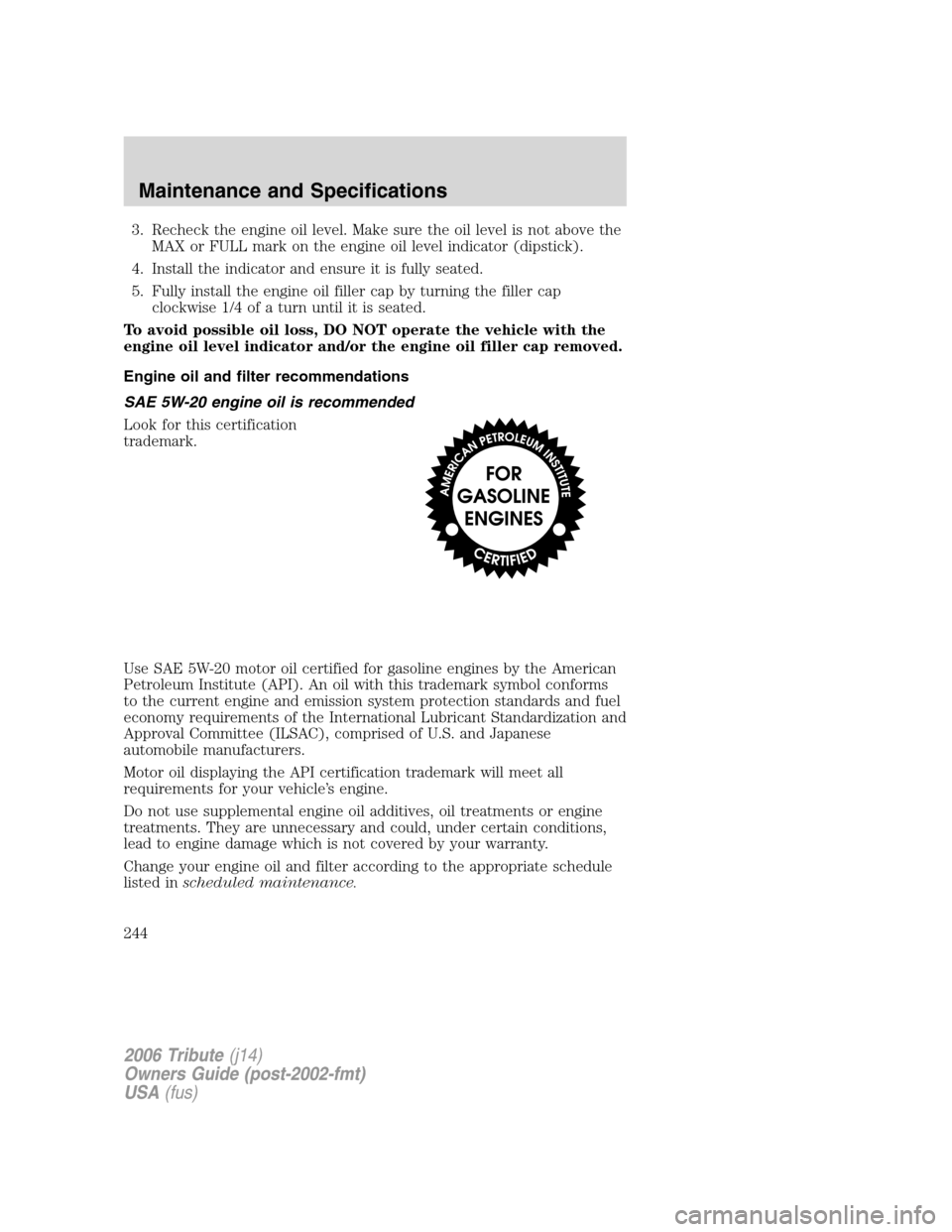
3. Recheck the engine oil level. Make sure the oil level is not above the
MAX or FULL mark on the engine oil level indicator (dipstick).
4. Install the indicator and ensure it is fully seated.
5. Fully install the engine oil filler cap by turning the filler cap
clockwise 1/4 of a turn until it is seated.
To avoid possible oil loss, DO NOT operate the vehicle with the
engine oil level indicator and/or the engine oil filler cap removed.
Engine oil and filter recommendations
SAE 5W-20 engine oil is recommended
Look for this certification
trademark.
Use SAE 5W-20 motor oil certified for gasoline engines by the American
Petroleum Institute (API). An oil with this trademark symbol conforms
to the current engine and emission system protection standards and fuel
economy requirements of the International Lubricant Standardization and
Approval Committee (ILSAC), comprised of U.S. and Japanese
automobile manufacturers.
Motor oil displaying the API certification trademark will meet all
requirements for your vehicle’s engine.
Do not use supplemental engine oil additives, oil treatments or engine
treatments. They are unnecessary and could, under certain conditions,
lead to engine damage which is not covered by your warranty.
Change your engine oil and filter according to the appropriate schedule
listed inscheduled maintenance.
2006 Tribute(j14)
Owners Guide (post-2002-fmt)
USA(fus)
Maintenance and Specifications
244
Page 245 of 288
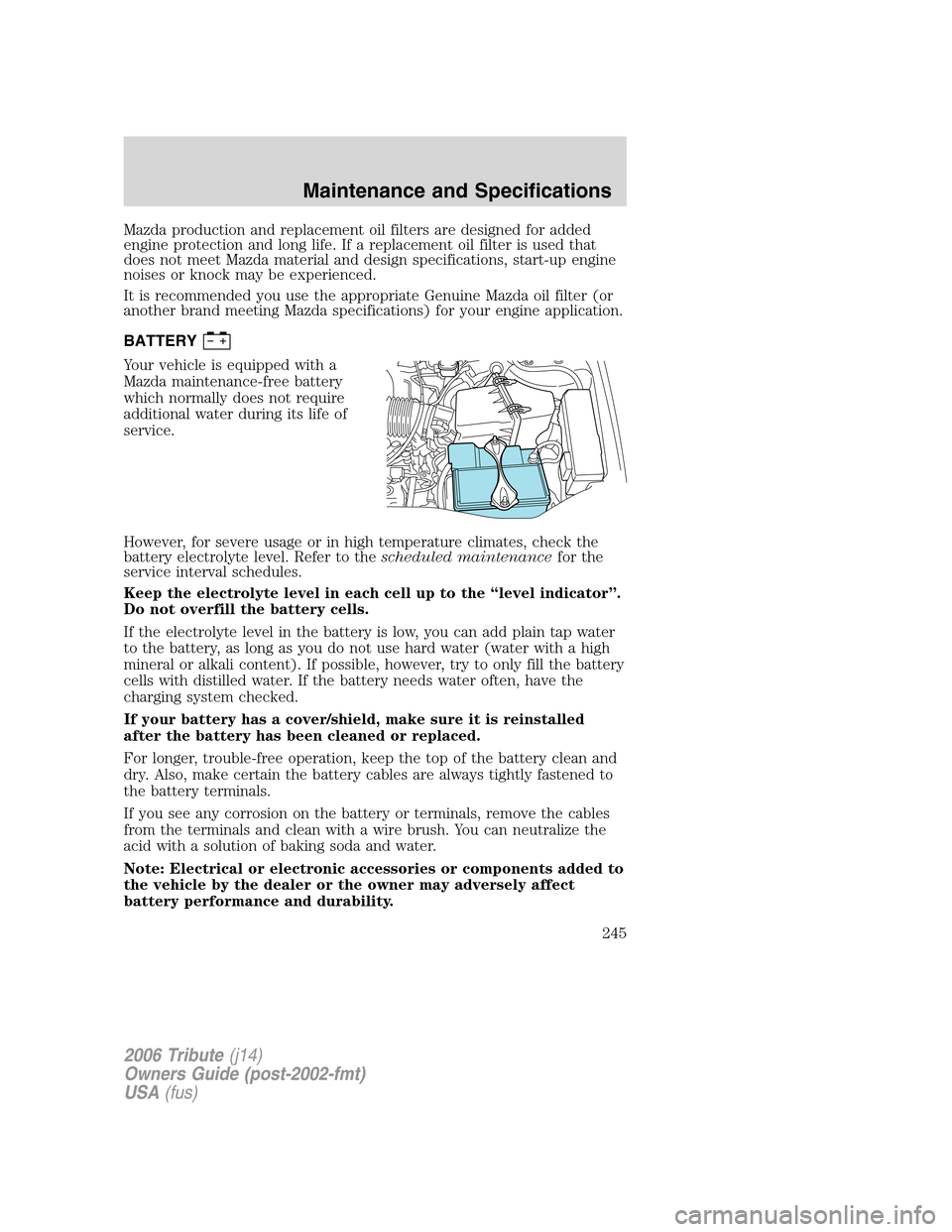
Mazda production and replacement oil filters are designed for added
engine protection and long life. If a replacement oil filter is used that
does not meet Mazda material and design specifications, start-up engine
noises or knock may be experienced.
It is recommended you use the appropriate Genuine Mazda oil filter (or
another brand meeting Mazda specifications) for your engine application.
BATTERY
Your vehicle is equipped with a
Mazda maintenance-free battery
which normally does not require
additional water during its life of
service.
However, for severe usage or in high temperature climates, check the
battery electrolyte level. Refer to thescheduled maintenancefor the
service interval schedules.
Keep the electrolyte level in each cell up to the “level indicator”.
Do not overfill the battery cells.
If the electrolyte level in the battery is low, you can add plain tap water
to the battery, as long as you do not use hard water (water with a high
mineral or alkali content). If possible, however, try to only fill the battery
cells with distilled water. If the battery needs water often, have the
charging system checked.
If your battery has a cover/shield, make sure it is reinstalled
after the battery has been cleaned or replaced.
For longer, trouble-free operation, keep the top of the battery clean and
dry. Also, make certain the battery cables are always tightly fastened to
the battery terminals.
If you see any corrosion on the battery or terminals, remove the cables
from the terminals and clean with a wire brush. You can neutralize the
acid with a solution of baking soda and water.
Note: Electrical or electronic accessories or components added to
the vehicle by the dealer or the owner may adversely affect
battery performance and durability.
2006 Tribute(j14)
Owners Guide (post-2002-fmt)
USA(fus)
Maintenance and Specifications
245